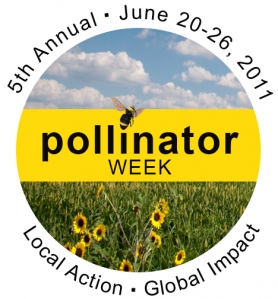- Planting roadsides with natives, including crop wild relatives. And here comes the database.
- Orange Maize: The Movies.
- VirtualKenya really here. Mother-in-law beside herself.
- Plant Cuttings is out. And all of a sudden I’m in a much better place.
- Small is beautiful, farm edition. And as chance would have it, coffee farm edition. And urban edition.
- Dispute at iconic coconut plantation resolved. Apparently there are some really unique varieties there.
- I say boniato. For the first and last time.
- Acacia on the brink. Easy, tiger. The name, not the genus.
- We’re going to need a better model.
- Pulque comes back. Never knew it had gone away.
- Domesticating fruit trees in Kenya. Something for VirtualKenya?
Bee good
 Wait, it’s National Pollinator Week? Not in Sweden, alas.
Wait, it’s National Pollinator Week? Not in Sweden, alas.
Nibbles: SusAg WWF-style, Obesity, Innovation, African farmers, Cyanobacteria, Climate change experiment
- See what WWF thinks will make agriculture sustainable.
- Americans are dying younger. Obesity partly to blame.
- Study shows how scientists can get farmers to innovate. And vice versa?
- Iron-age beer in France. “Beer … might have resembled modern home brews.” Which might have created a nation of wine-drinkers.
- Voice of America ♥ Nourishing the Planet. (African farmers also important.)
- Bacteria in mosses on tree branches fertilize forest soils. How long before the whole thing is available in a packet?
- Bioengineering the prairie. Together with, presumably, its crop wild relatives.
Protect and survive; building better-defended wheats
The United States Department of Agriculture broke ground yesterday on a new facility at the University of Minneapolis in St Paul, for studying stem rust and other fungal diseases in wheat.
“By expanding our commitment to research that targets crop diseases like Ug99, we can strengthen food security and reduce hunger and poverty in countries like Afghanistan, Bangladesh, Ethiopia and Pakistan,” said Robert Bertram, head of USAID’s Office of Agriculture, Research and Technology. “This research concurrently helps U.S. scientists protect America’s wheat crops.”
The groundbreaking ceremony was part of a four-day research conference sponsored by the Borlaug Global Rust Initiative. Not coincidentally, a report from a recent wheat-rust meeting at ICARDA is winging its way towards the experts attending the conference. You can download your own copy direct from ICARDA.
Brainfood: Bean diversity, Rice domestication, Microbial interactions squared, Threat of extinction, Agroforestry, Species diversity
- Population structure and genetic differentiation among the USDA common bean (Phaseolus vulgaris L.) core collection. Subpopulations detected within usual Middle American and Andean genepools. The former was more diverse. Diversity was lower for domestication loci. One wonders whether game worth candle.
- Artificial selection for a green revolution gene during japonica rice domestication. There’s nothing new under the sun. Fuller fills us in.
- Positive plant microbial interactions in perennial ryegrass dairy pasture systems. Plant-microbe interactions can have significant positive impact on production of, and chemical inputs into and losses from, perennial ryegrass dairy pasture systems. Gotta love that agrobiodiversity.
- Plant growth promoting potential of Pontibacter niistensis in cowpea (Vigna unguiculata (L.) Walp.). And another one. New bacterium from Western Ghats fertilizes soil and helps cowpea to grow.
- Extinction risk and diversification are linked in a plant biodiversity hotspot. That would the Cape. Extinction threat (IUCN categories) is better explained by phylogeny than by human activity or plant traits. Go figure.
- The framework tree species approach to conserve medicinal trees in Uganda. Sort of like artificial keystone species. Lots of other cool stuff in the same issue of Agroforestry Systems.
- Use of topographic variability for assessing plant diversity in agricultural landscapes. By and large, more environmental variability means more plant diversity, in Switzerland. Maybe some crop wild relatives in there?